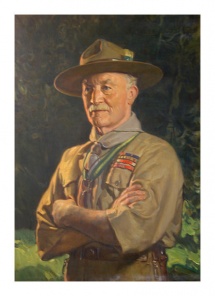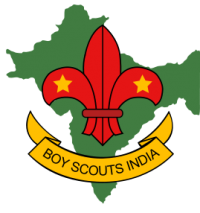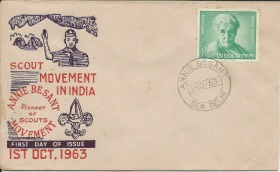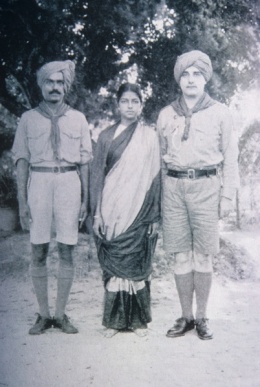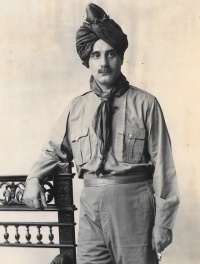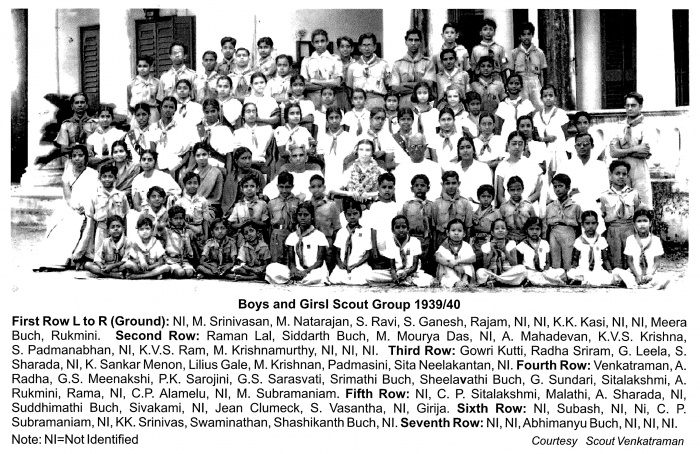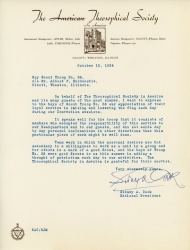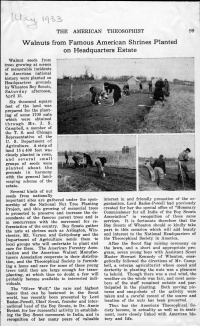Boy Scout Movement and Theosophical Movement: Difference between revisions
No edit summary |
|||
| (9 intermediate revisions by the same user not shown) | |||
| Line 17: | Line 17: | ||
She described the many useful contributions of Indian Scouts to society in fighting fires, assisting pilgrims, and finding lost children. They made stretchers made simply of two staves and a turban to carry cholera victims to shelter. "During epidemics of plague, cholera an the like, the scouts are always to the fore, till at last the government and the people called upon the nearest Scout Master whenever help was required."<ref>Wood, 190.</ref> | She described the many useful contributions of Indian Scouts to society in fighting fires, assisting pilgrims, and finding lost children. They made stretchers made simply of two staves and a turban to carry cholera victims to shelter. "During epidemics of plague, cholera an the like, the scouts are always to the fore, till at last the government and the people called upon the nearest Scout Master whenever help was required."<ref>Wood, 190.</ref> | ||
Mr. Pearce wrote in some detail about the history of scouting in India in the '''1918 ''[ | Mr. Pearce wrote in some detail about the history of scouting in India in the '''1918 ''[https://archive.org/details/ReportOfSPNE1918 Report of the Society for the Promotion of National Education]''''': | ||
<blockquote> | <blockquote> | ||
The seed of the I. B. S. A. was planted in Madanapalle College in June, 1916, by Mr. G. P. Aryaratna, a Patrol-Leader of my old Troop at Mahinda College, | The seed of the I. B. S. A. was planted in Madanapalle College in June, 1916, by Mr. G. P. Aryaratna, a Patrol-Leader of my old Troop at Mahinda College, | ||
| Line 58: | Line 58: | ||
</blockquote> | </blockquote> | ||
[[File:Scout leader with Arundales.jpg|260px|right|thumb|Unknown Scout leader with Rukmini and George Arundale]] | |||
Dr. Besant used her weekly national newspaper, [[New India (periodical)|''New India'']], to promote Scouting. For example, on May 23, | Dr. Besant used her weekly national newspaper, [[New India (periodical)|''New India'']], to promote Scouting. For example, on May 23, | ||
1923, an entire column of the paper was given to a description of a training camp for "Scouters" (Scout leaders) in Malayattoor, Cochin. About 25 men, representing all classes and castes, engaged in a full range of Scouting activities in a hilly forest location, demonstrating brotherhood and enthusiasm.<ref>V. Ramanathan, "Scout Notes: the First Scouters' Training Camp, Cochin," ''New India'' (May, 23, 1923), 4.</ref> [[Curuppumullage Jinarājadāsa|C. Jinarājadāsa]], who worked closely with Mrs. Besant for many years, wrote: | 1923, an entire column of the paper was given to a description of a training camp for "Scouters" (Scout leaders) in Malayattoor, Cochin. About 25 men, representing all classes and castes, engaged in a full range of Scouting activities in a hilly forest location, demonstrating brotherhood and enthusiasm.<ref>V. Ramanathan, "Scout Notes: the First Scouters' Training Camp, Cochin," ''New India'' (May, 23, 1923), 4.</ref> [[Curuppumullage Jinarājadāsa|C. Jinarājadāsa]], who worked closely with Mrs. Besant for many years, wrote: | ||
| Line 70: | Line 71: | ||
Perhaps you may like to know that I took the Scout's pledge from our Chief Scout, Sir Robert Baden-Powell, here in Madras, at a big Scout Rally.<ref>Annie Besant, "Annie Besant – Scout" ''The Theosophist'' 64 (October, 1942), 51. Reprint of a message delivered March 7, 1929.</ref> | Perhaps you may like to know that I took the Scout's pledge from our Chief Scout, Sir Robert Baden-Powell, here in Madras, at a big Scout Rally.<ref>Annie Besant, "Annie Besant – Scout" ''The Theosophist'' 64 (October, 1942), 51. Reprint of a message delivered March 7, 1929.</ref> | ||
</blockquote> | </blockquote> | ||
[[File:Scout | |||
[[File:George Arundale as Scout.jpg|200px|right|thumb|George Arundale in Scout uniform]] | |||
Two years later she wrote. | Two years later she wrote. | ||
<blockquote> | <blockquote> | ||
Looking back over a long life, now that I am more than eighty years of age… I am inclined to say that I consider the part I took in the introduction of Indian boys and youths into the Scout Movement was one of the most useful steps in my life. It bought together the young of the two Nations and founded, I hope and believe, many friendships which will last after the two go out into the larger world… Games and athletic exercises are among the most pleasant and potent ways of forming lasting friendships..<ref>Annie Besant, "A Message to Indian Scouts" ''The Theosophist'' 52 (March, 1931), 420b. </ref> | Looking back over a long life, now that I am more than eighty years of age… I am inclined to say that I consider the part I took in the introduction of Indian boys and youths into the Scout Movement was one of the most useful steps in my life. It bought together the young of the two Nations and founded, I hope and believe, many friendships which will last after the two go out into the larger world… Games and athletic exercises are among the most pleasant and potent ways of forming lasting friendships..<ref>Annie Besant, "A Message to Indian Scouts" ''The Theosophist'' 52 (March, 1931), 420b. </ref> | ||
</blockquote> | </blockquote> | ||
Dr. Besant was given the '''Silver Wolf Award''' by Lord Baden-Powell | Dr. Besant was given the '''Silver Wolf Award''' by Lord Baden-Powell on September 29, 1932. It is the highest honor offered by the Scout Movement.<ref>"Chronicle of Events" ''The Theosophical Year Book, 1938'' (Adyar, Madras, India: Theosophical Publishing House, 1938), 49.</ref> | ||
=== George Arundale and Indian Scouting === | === George Arundale and Indian Scouting === | ||
| Line 89: | Line 91: | ||
The Scout and Girl Guide Movements exist to produce good citizens...<ref>Arundale, 65.</ref> | The Scout and Girl Guide Movements exist to produce good citizens...<ref>Arundale, 65.</ref> | ||
</blockquote> | </blockquote> | ||
A '''campground''' for scouts was established at the [[Adyar (campus)|Adyar headquarters campus]] of the Theosophical society. One of Dr. Arundale's long-time coworkers in scouting at Adyar was S. Venkataraman (1920-2008). He "understood that three-fourths of the word ‘scouting’ is ‘outing’. In his capacity as Adviser to the Besant Scout Camping Centre of the TS, Adyar, he promoted a great variety of scouting activities. With persistent effort he used to contact even reluctant scout groups in and around the city by pulling and pushing | |||
them into tent-camps."<ref>[http://www.ts-adyar.org/sites/default/files/pdf/anl/Adyar%20Newsletter%20Feb%202008.pdf "A Tribute To S. Venkataraman (1920–2008)"] in ''Adyar Newsletter'' (February, 2008), 7.</ref> | |||
[[File:Boy and Girl Scouts 1939-1940.jpg|center|700px|thumb|Boy and Girl Scouts at Adyar, 1930-1940.]] | [[File:Boy and Girl Scouts 1939-1940.jpg|center|700px|thumb|Boy and Girl Scouts at Adyar, 1930-1940.]] | ||
| Line 112: | Line 117: | ||
=== Troop 38 === | === Troop 38 === | ||
The headquarters of the [[American Theosophical Society]] [renamed in 1934 to [[Theosophical Society in America]]] in Wheaton, Illinois sponsored a scout troop in the 1930s. TS members Albert F. Hardcastle | The headquarters of the [[American Theosophical Society]] [renamed in 1934 to [[Theosophical Society in America]]] in Wheaton, Illinois, with the Olcott Lodge, sponsored a scout troop in the 1930s.<ref>"What Lodges are Doing: Olcott Lodge," ''The American Theosophist'' 23 no. 7 (Jul 1935), 163.</ref> TS members Albert F. Hardcastle, Donald Greenwood, and Byron Bole served as scoutmasters, and Society president [[Sidney A. Cook]] was chairman of the troop committee. Society staff members and other local Theosophists helped by raising funds. Helen Browne Freund, an opera singer, performed a benefit concert. | ||
One of the services that the scouts performed was raising and lowering the American flag every day during the Society's 1934 summer convention. These are some of the troop's other activities: | One of the services that the scouts performed was raising and lowering the American flag every day during the Society's 1934 summer convention. These are some of the troop's other activities: | ||
| Line 121: | Line 126: | ||
[[File:Walnut planting article.jpg|200px|right|thumb|Article about walnut project in ''The American Theosophist'']] | [[File:Walnut planting article.jpg|200px|right|thumb|Article about walnut project in ''The American Theosophist'']] | ||
=== 1933 Walnut Tree Planting === | === 1933 Walnut Tree Planting === | ||
On April 15, 1933, Troop 38 and the staff of the [[American Theosophical Society]] [[Olcott (campus)|headquarters]] participated in the '''National Nut Tree Planting Project''', which was a cooperative effort to plant one million trees each year for five years. Black walnuts and other varieties were collected by Boy Scouts from national shrines such as George Washington's Mount Vernon estate, Gettysburg battlefield, and Arlington National Cemetery, and shipped across the country. Theosophical Society staff members worked with Scouts to clear a 6000 square foot nursery bed, 15 feet by 400 feet in size, and together planted the 1700 nuts that were provided. Leading the effort was Mr. John S. Campbell, a member of the TS and Chicago Representative of the U. S. Department of Agriculture. After two years, the young trees were four feet tall, and were distributed to permanent locations in the local community. The first twelve went to an experimental farm near Wheaton, with the boys of Troop 38 present, along with their adult Theosophical Society leaders | On April 15, 1933, Troop 38 and the staff of the [[American Theosophical Society]] [[Olcott (campus)|headquarters]] participated in the '''National Nut Tree Planting Project''', which was a cooperative effort to plant one million trees each year for five years. Black walnuts and other varieties were collected by Boy Scouts from national shrines such as George Washington's Mount Vernon estate, Gettysburg battlefield, and Arlington National Cemetery, and shipped across the country. Theosophical Society staff members worked with Scouts to clear a 6000 square foot nursery bed in the headquarters campus, 15 feet by 400 feet in size, and together planted the 1700 nuts that were provided. Leading the effort was Mr. John S. Campbell, a member of the TS and Chicago Representative of the U. S. Department of Agriculture. After two years, the young trees were four feet tall, and were distributed to permanent locations in the local community. The first twelve went to an experimental farm near Wheaton, with the boys of Troop 38 present, along with their adult Theosophical Society leaders – Mr. and Mrs. Campbell, Albert F. Hardcastle, and Donald W. Greenwood.<ref>Frank Ridgway, "Day by Day Story of the Experimental Farm" ''Chicago Daily Tribune'' (November 11, 1935).</ref> | ||
<gallery> | <gallery> | ||
| Line 132: | Line 138: | ||
File:Nut Tree Planting certificate.jpg|Offical certificate from American Forestry Association | File:Nut Tree Planting certificate.jpg|Offical certificate from American Forestry Association | ||
</gallery> | </gallery> | ||
In another related '''Armistice Day''' event, two young walnut trees, shipped from Arlington National Cemetery and Mount Vernon, were planted in the "Historic Grove" on the headquarters campus. This took place on November 11 in remembrance of the end of World War I. | |||
<blockquote> | |||
The ceremony began with the Scout salute at the raising of the flag. Then just as the two celebrated trees were to be placed in the ground, the special Scout pledge to trees was reverently given while the boys stood with the Scout sign... | |||
Mr. Sidney A. Cook delivered a stirring talk urging every Citizen to become more interested in his country's problems and endeavor to help in those problems by a closer understanding of national history and of American's present affairs in world relationships...<ref>"Armistice Day Tree Planting" ''The American Theosophist'' 12.12 (December, 1933), 272-273.</ref> | |||
</blockquote> | |||
== Notes == | == Notes == | ||
<references/> | <references/> | ||
[[Category:Miscellaneous]] | [[Category:Miscellaneous]] | ||
[[Category:Umbrella articles]] | |||
[[Category:Theosophical worldview]] | |||
Latest revision as of 17:14, 12 November 2024
The international Scout Movement was founded in 1907 by Robert Baden-Powell, a lieutenant general in the British army. His aim was to provide young people with wholesome activities such as camping and hiking, opportunity for self-development, and training in citizenship, leadership, and brotherhood. Theosophists quickly saw that the Scout Movement shared many of its values, particularly in providing opportunities for youth all over the world to engage peacefully with each other.
Dr. Annie Besant, President of the Theosophical Society based in Adyar, Madras, India often said that "there were two great Movements which stood for Universal Brotherhood. One was the Theosophical Society ... And the second, the World Boy Scout Movement."[1]
Scouting in India
Boy Scout troops were established in India as early as 1909 in Allahabad, but were open only to boys of English and Anglo-Indian families.[2]
The beginnings of Indian Scouting
Hilda Wood wrote a detailed account of the early days of the Scout Movement in India.
The first movement of Boy Scouts in India was due indirectly to Mr. C. W. Leadbeater, who had spoken very highly of the training, and shown General Baden-Powell's book [Scouting for Boys] to his private secretary, Mr. Ernest Wood. The result of this was that in 1913, when Mr. Wood became Hon. Secretary of the Theosophical Education Trust, he introduced scouting at the High School at Madanapalle... where the first Troop was started under the leadership of Mr. Deobhankar. About a year later Mr. Wood arranged with Mr. [Frederick Gordon] Pearce, Assistant Commissioner for Boy Scouts in Ceylon, to send a thoroughly trained Scout Master to Madanapalle; the result was the arrival there of Mr. Aryarathna, who very soon trained a really first class Troop. Stimulated by this success, other Troups sprang up in various places.[3]
She described the many useful contributions of Indian Scouts to society in fighting fires, assisting pilgrims, and finding lost children. They made stretchers made simply of two staves and a turban to carry cholera victims to shelter. "During epidemics of plague, cholera an the like, the scouts are always to the fore, till at last the government and the people called upon the nearest Scout Master whenever help was required."[4]
Mr. Pearce wrote in some detail about the history of scouting in India in the 1918 Report of the Society for the Promotion of National Education:
The seed of the I. B. S. A. was planted in Madanapalle College in June, 1916, by Mr. G. P. Aryaratna, a Patrol-Leader of my old Troop at Mahinda College, Galle, Ceylon, whom I sent to Madanapalle in the hope that he would be able to develop Scouting there, since it had already shown itself so valuable as training for Ceylon boys. That hope was fulfilled, for the Troop he founded flourished amazingly and produced many splendid Scouts and proved conclusively, if proof were necessary, that the system was adaptable to Indian conditions...
In 1917 the Indian Boy Scouts Association took definite shape as an organisation distinct from Sir Robert Baden-Powell's. The reasons for this are plain enough. It was my private hope in December, 1916, that this Movement might be linked to the original Baden-Powell Movement, just as was the case with the Ceylon Troops I had organised in 1915 and 1916. I expressed this hope in a letter published in New India in December, 1916. I also wrote to Mr. Arundale on the subject. These hopes were, however, much damped by the fact that the requests sent by the Madanapalle Troop to the Baden-Powell officials were either ignored altogether or received unsatisfactory answers. Unlike in Ceylon, where the Baden-Powell Movement was organised from the first among Sinhalese boys and with full confidence in Sinhalese and Tamil Scoutmasters, the Baden-Powell Movement in India was limited to Europeans, Anglo-Indians, and a few Indian Christians, all under European Scoutmasters...
The Indian Boy Scouts Association took shape therefore throughout 1917 under the guidance and inspiration of Mrs. Besant, with Mr. Arundale, Lieutenant Tarini Sinha and Mr. Sanjiva Kamath as the chief organisers...[5]
Scouting in Indian schools
Most schools supervised by the Society for the Promotion of National Education placed great emphasis on scouting, which was an integral part of the curriculum. For example, the National High School at Hyderabad, Sindh, reported in 1918:
The appointments of a qualified Physical Instructor and of a trained Scout Commissioner have given a great impetus to Physical Culture and Scouting. Every class in the school takes Drill twice a week and scout games are very popular. Good grounds have been laid out for team games, and hockey, cricket and foot-ball are played with much zest. The scouts have formed a troop of their own, and their example is being followed by other local institutions. All the students are imbued with a fine spirit of service and did good service in putting down two big fires and serving as volunteers at two special Conferences at Karachi and Hyderabad. Their work on these occasions was publicly commended.[6]
The Andhra Jatheeya Kalasala, Masulipatam in Madras wrote: "Volunteering and relief-work is set as occasion arises as a lesson in self-discipline and organisation and a scout-section is a permanent adjunct of the Institution and its work."[7] The National Boys School in Benares City reported:
Scouting has become one of the chief activities of the school, and has had a most beneficial influence on the students, improving their health and spirits, and stimulating in them the spirit of service and an esprit de corps. Frequent camping excursions are made on holidays, and there have been instruction classes in first aid, ambulance, fire-drill, signalling, tracking, music, cooking, etc. During the Kumbha Mela [a major pilgrimage] at Allahabad, some of the Scouts and members of the Band of Service attached to the school did excellent work and impressed the authorities by their energy, high sense of duty and courage.[8]
The IBSA Scout camp scene below shows bridge building (left), stretcher bearing, fire rescue, and tent building.
Annie Besant and Indian Scouting
In 1918, Dr. Annie Besant organized the Indian Boy Scout Movement, with the aid of Mr. Pearce and Shri M. V. Venkateshwaran.
Lord Pentland, the then Governor of Madras [now Chennai], organized another Association confined to English and Anglo-Indian boys. These two organizations were popularly known as Besant Scouts and Pentland Scouts. When Lord Baden-Powell came to India in 1921 Dr. Besant, who liked him immensely, expressed her willingness to help a union in every possible way. One particular obstacle was that the Pentland Scouts insisted that even if the Indian Scouts joined them they should wear the Scout hat and shoes, whereas the Besant Scouts insisted on wearing the green turban and be permitted to go barefoot if they so desired. Baden-Powell did not consider that the Scout hat ... was anything essential as a part of the equipment of a Scout and readily agreed to the use of the turban. The amalgamation of the two organizations then took place, and Dr. Besant was appointed Honorary Commissioner for All-India of the Boy Scouts Association.[9]
Dr. Besant used her weekly national newspaper, New India, to promote Scouting. For example, on May 23, 1923, an entire column of the paper was given to a description of a training camp for "Scouters" (Scout leaders) in Malayattoor, Cochin. About 25 men, representing all classes and castes, engaged in a full range of Scouting activities in a hilly forest location, demonstrating brotherhood and enthusiasm.[10] C. Jinarājadāsa, who worked closely with Mrs. Besant for many years, wrote:
To identify herself more closely with the Scout Movement, she had woven for her a silk sari of khaki colour, with a green border, and a turban in khaki on which was placed the Scout emblem. Whenever in her later years she was present at a Scout Rally she was always dressed in this Scout uniform.[11]
She wrote a message to the scouts at Adyar in 1929:
If I had a dozen sons – I have only one – I would send them all into the Scout Movement, as soon as they could enter its lowest grade. And I would send the daughters into the Girl Guides… Now do you think that I could say anything stronger than that, as a recommendation to you, who read this, in the way of advice as to joining the Scouts or the Guides…
Perhaps you may like to know that I took the Scout's pledge from our Chief Scout, Sir Robert Baden-Powell, here in Madras, at a big Scout Rally.[12]
Two years later she wrote.
Looking back over a long life, now that I am more than eighty years of age… I am inclined to say that I consider the part I took in the introduction of Indian boys and youths into the Scout Movement was one of the most useful steps in my life. It bought together the young of the two Nations and founded, I hope and believe, many friendships which will last after the two go out into the larger world… Games and athletic exercises are among the most pleasant and potent ways of forming lasting friendships..[13]
Dr. Besant was given the Silver Wolf Award by Lord Baden-Powell on September 29, 1932. It is the highest honor offered by the Scout Movement.[14]
George Arundale and Indian Scouting
During his years as Principal of Central Hindu College, George S. Arundale became a Scout Officer, and he continued his work with the Scouts well into his term as president of the Theosophical Society, serving as Vice-President of the Provincial Council of the Boy Scout Association in the Madras Presidency.[15]
By 1933 when he began his term as TS president, the Scout Movement had expanded into at least 32 countries, with a total of 2,251,726 Scouts.[16]
In 1935 Dr. Arundale delivered a radio address on the Madras Corporation Broadcasting Station, describing the benefits of the Scout Movement to India:
If India is to achieve material well-being, if she is to become, within the great Commonwealth of Nations to which she belongs, a potent force for peace and international comradeship, she must have good citizens - boys and girls, men and women; for citizenship begins at birth, first with rights, but soon with duties.
The Scout and Girl Guide Movements exist to produce good citizens...[17]
A campground for scouts was established at the Adyar headquarters campus of the Theosophical society. One of Dr. Arundale's long-time coworkers in scouting at Adyar was S. Venkataraman (1920-2008). He "understood that three-fourths of the word ‘scouting’ is ‘outing’. In his capacity as Adviser to the Besant Scout Camping Centre of the TS, Adyar, he promoted a great variety of scouting activities. With persistent effort he used to contact even reluctant scout groups in and around the city by pulling and pushing them into tent-camps."[18]
Boy Scouts’ Hobby Club
The Boy Scouts' Hobby Club formed in 1923 at Mizar Lodge in Conjeeveram [now Kanchipuram] in south India. The objective was to encourage scouts worldwide to engage in correspondence to strengthen a sense of brotherhood by discussing hobbies. All members received the international magazine of the club, Brotherhood.[19]
Scouting in Sri Lanka
In Ceylon (now Sri Lanka), "the Baden-Powell Movement was organised from the first among Sinhalese boys and with full confidence in Sinhalese and Tamil Scoutmasters,"[20] circumstances very different from those experienced by early scouts in India. Scout troupes were established at several schools operated by the Buddhist Theosophical Society:
- 1913 – Dharmaraja College, Kandy
- 1914 – Mahinda College, Galle
- 1916 – Ananda College, Colombo
The principal of Mahinda College, Frederick Gordon Pearce, and Mr. G. P. Aryaratna, Patrol-Leader, established the very successful troop at Mahinda College. Both were recruited to help establish scouting in India.
Scouting in United States
Theosophists, like Americans generally, were very supportive of the Boys Scouts and Girl Scouts. As early as 1913, Alma Kunz wrote a book review of the Boy Scout Handbook.[21] Adelia H. Taffinder saw the Boy Scout Movement as a natural adjunct to the Order of the Star in the East, and wrote in great detail about the requirements for Scouts.[22] The headquarters of the Theosophical Society in America, under the leadership of Sidney A. Cook, the Society's president, sponsored a scout troop in the 1930s . He encouraged the Diamond T Motor Truck Company, of which he was an officer, to support the Chicago Council of the Boy Scouts of America. The company received an illustrated brochure of appreciation.[23] Herbert A. Kern, Sr., an influential member of the Society, was chairman of the Southwest District of the Boy Scouts of America, Chicago.
Troop 38
The headquarters of the American Theosophical Society [renamed in 1934 to Theosophical Society in America] in Wheaton, Illinois, with the Olcott Lodge, sponsored a scout troop in the 1930s.[24] TS members Albert F. Hardcastle, Donald Greenwood, and Byron Bole served as scoutmasters, and Society president Sidney A. Cook was chairman of the troop committee. Society staff members and other local Theosophists helped by raising funds. Helen Browne Freund, an opera singer, performed a benefit concert.
One of the services that the scouts performed was raising and lowering the American flag every day during the Society's 1934 summer convention. These are some of the troop's other activities:
- Performed in a circus with other Scout troops.
- Assisted at a horse and mule pulling contest at Colonel McCormick's farm performing first aid, parking cars, and delivering messages.
- Attended Outdoor University, which was provided by Du Page Area Council of the Boy Scouts of America. Instruction was in campcraft, outdoor cooking, and nature study.
- Participated in a winter rally where teams competed in drills, signaling, first aid, knot tying, and making fire by friction.[25]
1933 Walnut Tree Planting
On April 15, 1933, Troop 38 and the staff of the American Theosophical Society headquarters participated in the National Nut Tree Planting Project, which was a cooperative effort to plant one million trees each year for five years. Black walnuts and other varieties were collected by Boy Scouts from national shrines such as George Washington's Mount Vernon estate, Gettysburg battlefield, and Arlington National Cemetery, and shipped across the country. Theosophical Society staff members worked with Scouts to clear a 6000 square foot nursery bed in the headquarters campus, 15 feet by 400 feet in size, and together planted the 1700 nuts that were provided. Leading the effort was Mr. John S. Campbell, a member of the TS and Chicago Representative of the U. S. Department of Agriculture. After two years, the young trees were four feet tall, and were distributed to permanent locations in the local community. The first twelve went to an experimental farm near Wheaton, with the boys of Troop 38 present, along with their adult Theosophical Society leaders – Mr. and Mrs. Campbell, Albert F. Hardcastle, and Donald W. Greenwood.[26]
In another related Armistice Day event, two young walnut trees, shipped from Arlington National Cemetery and Mount Vernon, were planted in the "Historic Grove" on the headquarters campus. This took place on November 11 in remembrance of the end of World War I.
The ceremony began with the Scout salute at the raising of the flag. Then just as the two celebrated trees were to be placed in the ground, the special Scout pledge to trees was reverently given while the boys stood with the Scout sign...
Mr. Sidney A. Cook delivered a stirring talk urging every Citizen to become more interested in his country's problems and endeavor to help in those problems by a closer understanding of national history and of American's present affairs in world relationships...[27]
Notes
- ↑ C. Jinarajadasa, "Dr. Besant and the Scout Movement" The Theosophist 69 (November, 1947), 157.
- ↑ Bharat Guides and Scouts web page.
- ↑ Hilda Wood, "The Indian Boy Scouts," The Messenger 9.8 (January, 1922), 190.
- ↑ Wood, 190.
- ↑ "The Indian Scouts," Report of the Society for the Promotion of National Education, 1918 (Adyar, Madras, India: The Society for the Promotion of National Education, 1918), 46-47.
- ↑ "The National High School, Hyderabad, Sindh" Report of the Society for the Promotion of National Education, 1918, 27.
- ↑ "The Andhra Jatheeya Kalasala," Report of the Society for the Promotion of National Education, 1918, 40.
- ↑ "The National High School, Benares City" Report of the Society for the Promotion of National Education, 1919 (Adyar, Madras, India: The Society for the Promotion of National Education, 1919), 79.
- ↑ C. Jinarajadasa, "Dr. Besant and the Scout Movement" The Theosophist 69 (November, 1947), 156-157.
- ↑ V. Ramanathan, "Scout Notes: the First Scouters' Training Camp, Cochin," New India (May, 23, 1923), 4.
- ↑ C. Jinarajadasa, "Dr. Besant and the Scout Movement" The Theosophist 69 (November, 1947), 158.
- ↑ Annie Besant, "Annie Besant – Scout" The Theosophist 64 (October, 1942), 51. Reprint of a message delivered March 7, 1929.
- ↑ Annie Besant, "A Message to Indian Scouts" The Theosophist 52 (March, 1931), 420b.
- ↑ "Chronicle of Events" The Theosophical Year Book, 1938 (Adyar, Madras, India: Theosophical Publishing House, 1938), 49.
- ↑ George S. Arundale "How the Boy Scout Movement Helps the World" The Theosophist 56 (April 1935), 65.
- ↑ Anonymous, "Boy Scouts: The Growth of the Movement" The Theosophist 57 (January, 1936), 381.
- ↑ Arundale, 65.
- ↑ "A Tribute To S. Venkataraman (1920–2008)" in Adyar Newsletter (February, 2008), 7.
- ↑ S. R. Krishnan, "The Boy Scouts' Hobby Club" The Theosophist 44 (February, 1923), 558.
- ↑ "The National High School," General Report of the T. S., 1918, 46-47.
- ↑ AFK [Alma Kunz], Review of The Boys Scouts of American: Handbook for Boys The American Theosophist 14.12 (September, 1913), 1028.
- ↑ Adelia H. Taffinder, "Scoutcraft in America" The Herald of the Star 6 (December, 1917), 636.
- ↑ Perry A. Lint "An Expression of Appreciation." [illustrated brochure] Sidney A. Cook Papers. Records Series 08.08. Theosophical Society in America Archives.
- ↑ "What Lodges are Doing: Olcott Lodge," The American Theosophist 23 no. 7 (Jul 1935), 163.
- ↑ Various pieces of correspondence. Sidney A. Cook Papers. Records Series 08.08. Theosophical Society in America Archives.
- ↑ Frank Ridgway, "Day by Day Story of the Experimental Farm" Chicago Daily Tribune (November 11, 1935).
- ↑ "Armistice Day Tree Planting" The American Theosophist 12.12 (December, 1933), 272-273.
